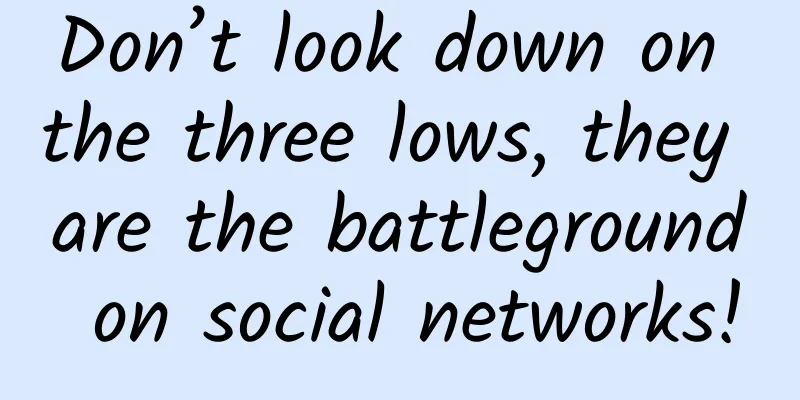Don’t look down on the three lows, they are the battleground on social networks!

|
In June this year, the New Media Blue Book released by the Chinese Academy of Social Sciences pointed out that the "three lows" are still the main force of Weibo, that is, people with low education, low age and low income. The report caused a lot of controversy after its release, and there were inevitably people who took the opportunity to step on it. Of course, many people also questioned the definition of the three lows, especially low income. Although the "three lows" label seems a bit low, considering the development status of the platform, if Weibo wants to achieve a breakthrough, it may really have to do enough work on the "three lows". First, continue to seize “low” tier cities. Whoever wins the users wins the world. In today's rapidly changing Internet market, user growth often impresses the capital market more than business models. So we see that UBER, Didi, and Kuaidi are desperately launching various offers to attract people, and then they receive rounds of financing one after another, and the value of these companies is rising all the way. In contrast, why Twitter, the originator of microblogs, has been repeatedly criticized recently is related to its weak growth in active users. It is said that the second quarter of this year is the slowest quarter for the number of monthly active users of Twitter since its listing in 2013. Weibo, which is about to celebrate its sixth anniversary, seems to be regaining vitality in terms of user growth. According to the latest financial report, by the second quarter of this year, Weibo's monthly active users had exceeded 200 million to reach 212 million, with a year-on-year growth of more than 30% for nine consecutive quarters, including a net increase of 36 million in the first half of 2015. At this rate, Weibo is likely to break the record of 47 million monthly active users in 2014. With the saturation of first- and second-tier cities, lower-tier cities have become the main battlefield for the growth of monthly active users of Weibo. CNNIC previously pointed out in a report that among the user composition of various microblogging platforms, Sina Weibo used to be mainly in first- and second-tier cities, while Tencent Weibo was mainly in third- to fifth-tier cities. However, last year, Tencent Weibo was merged into Tencent.com and stopped function updates, which created a vacuum in user demand in third- to fifth-tier cities, objectively providing favorable conditions for Sina Weibo to sink. Facing the opportunities, Weibo not only actively participated in the Spring Festival red envelope war, but also vigorously promoted strategic cooperation with TV variety shows, movies, and mobile phone manufacturers to expand user coverage through these most influential market channels. In the first half of this year, Weibo has cooperated with more than 100 variety TV programs, 86 movies, and 20 mainstream mobile phone manufacturers. The result of the cooperation is that Weibo's user penetration rate in second- and third-tier cities has increased significantly. As for the future, as the gap in mobile Internet access conditions between regions narrows, there is still room for the scale of Weibo users in low-tier cities to continue to expand. Secondly, make every effort to attract “young” users. The young users here largely refer to young users, who have always been the driving force behind the development of the Internet. But how old is considered a young user? This standard is actually constantly decreasing with the popularization of the Internet. In addition to the above-mentioned macro environment, what is the significance of competing for young users for Weibo? First, continue to maintain or even expand the status of the best platform for celebrities and fans to interact. From Yao Chen to EXO to TFBOYS, the popular stars on Weibo are getting younger and younger. The emerging new generation of idols need to be sought after by more younger fans. It is worth mentioning that these fans have been inextricably linked to the Internet since birth, and are more likely to explode on the Internet, so Lu Han's fans and Wang Junkai's fans have set a world record for their idols. According to a research report by Analysys International, people born after 1995 basically do not use WeChat. If Weibo can grab the market of people born after 1995 with the help of the new generation of idols, it will be a major benefit. Second, in the era of pan-entertainment, young users are more sensitive to new things. Even if they don’t create them themselves, they can gather popular online buzzwords and fashions through a lot of participation. In contrast, they are more eager to show their personal value. The specific manifestations on Weibo include a lot of participation in discussions on topics of interest and various "show-offs". It is reported that the average daily playback volume of Weibo mobile videos has increased nearly four times compared to six months ago. It can be said that young users have become an important driving force for Weibo's multimedia strategy, and have also laid the foundation for the launch of multimedia advertising products in the future. Third, although young users seem to form their own system, they are actually deeply connected with their families, teachers, educational institutions and even recruitment agencies. Family members and teachers can watch the daily life of young users through Weibo, while educational and recruitment agencies can actively establish relationships with young users through Weibo. The activeness of young users is expected to drive the collective activity of people around them. To sum up in one sentence, low-tier cities are an important battlefield for the growth of active Weibo users, and younger users are an important guarantee for maintaining or even improving Weibo's activity. ***, lower the threshold as much as possible. With the continued growth of active users and stable activity, Weibo has the confidence to make more attempts in commercialization. What needs to be done next is to improve the rules and lower the threshold for companies to participate in social marketing as much as possible. Among them, formulating perfect rules is an important prerequisite for opening the door to customers. Weibo was previously complained that "excessive commercialization destroyed the user experience", which to a certain extent was paying for the crude marketing behavior of some third parties. Therefore, Weibo not only issued relevant regulations, but also launched an information flow optimization plan since last year to focus on cracking down on false and harassing marketing information. In order to protect the user experience, information flow optimization will continue to be promoted, and how to balance user experience and commercial marketing will continue to test Weibo's wisdom. Lowering the threshold is more like an attitude, that is, all enterprises are welcome to build brands, expand brands and even achieve influence conversion on Weibo under the premise of abiding by the rules. In order to help enterprises build confidence, Weibo needs to provide more abundant and efficient business products and even help enterprises innovate their business models. Judging from recent performance, Weibo is constantly releasing its "low threshold" attitude. With more than 1 million companies opening Weibo accounts, Weibo fully opened its information flow advertising products to brand companies, small and medium-sized enterprises and individual users in the first half of the year, effectively stimulating the small and medium-sized market. In the second quarter, Weibo's revenue from small and medium-sized enterprises and self-service advertising increased by 163% year-on-year, and the number of customers exceeded 440,000, a net increase of 54,000 from the previous month, starting to realize the chain effect of "self-service advertising-small and medium-sized advertising-brand advertising". In addition, after more than two years of accumulation, Weibo has begun to reap rewards in the integration of TV and the Internet. It has not only expanded its user coverage, but also improved the sales efficiency of variety shows, allowing more companies to take advantage of popular variety shows for promotion. Of course, the integration of TV and the Internet is only the first step. To stimulate customer investment, Weibo needs to make more attempts in variety shows and even other fields to help companies explore business models, which is also crucial for the advancement of Weibo's verticalization strategy. Of course, in the process of digging deeper, Weibo will also face strong challenges from rivals such as WeChat, and it cannot be taken lightly at any time. |
<<: How to use AFNetworking in Swift
>>: WeChat announces eight hardware industry solutions for the first time
Recommend
From tactics to strategy, 7 ways to get early seed users for App promotion
All startups will face the problem of how to acqu...
6 excellent copywriting strategies to teach you how to write sharp copy!
"One good copy is worth 100 sales experts.&q...
Will a credit card limit reduction affect my credit report? The situation is as follows
Will a credit card limit reduction be reflected i...
Short video account positioning and operation methods!
In the process of operating short video accounts,...
WeChat will stop opening the App technical service for Mini Programs after May 19
On May 14, the WeChat Open Community released a n...
27 quick money-making projects for lazy people
Real-life cases + practical techniques will teach...
Things to note when bidding for multiple websites at the same time! How to bid for ranking?
The site group strategy of SEM strategy is differ...
up to date! Reference data of 39 information flow platforms!!
The November data of major information flow platf...
Douyin promotion methods, the most comprehensive guide to increasing Douyin fans!
For the promotion and operation of Tik Tok, is it...
How much does it cost to rent a large online game server?
How much does a large online game server cost? Ma...
Tik Tok monetization methods and its development trends!
For commercial products, monetization is an unavo...
Android performance optimization memory
Google recently released an online course on Andr...
Xiaohongshu keyword optimization and promotion marketing skills!
The rapid development of Xiaohongshu has diversif...
Thinking about graying out buttons
A few days ago, a colleague was working on a form...
Amateur experts help Apple with design: How to make the notification bar in iOS 11 more useful?
Editor's note: Love is the root of all evil. ...









